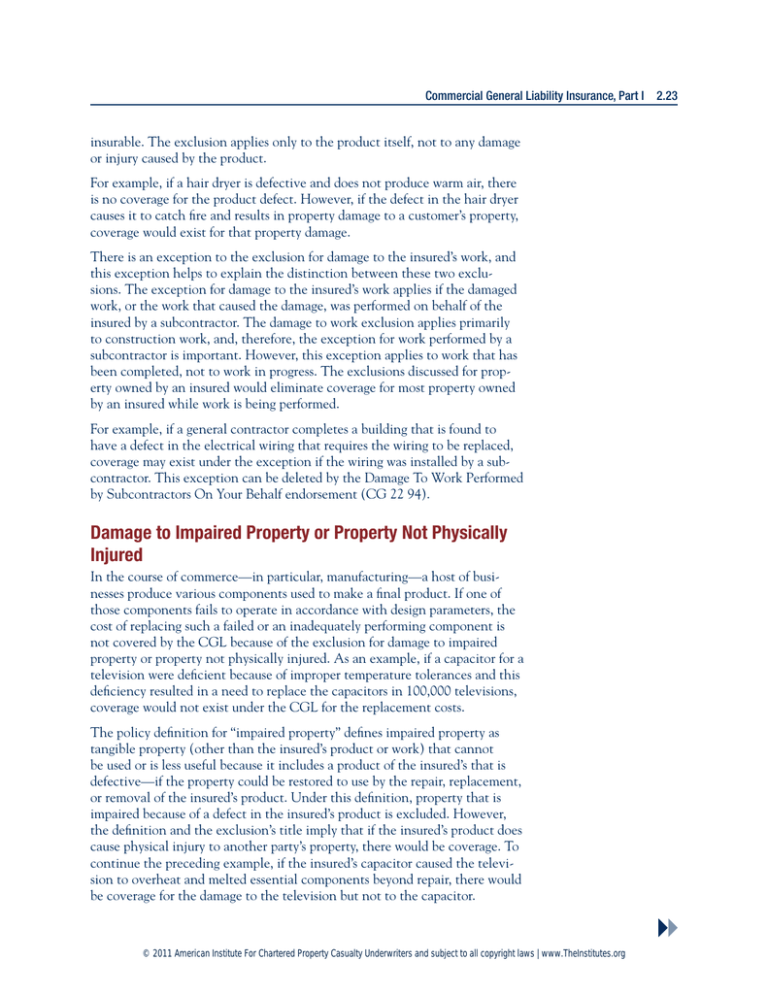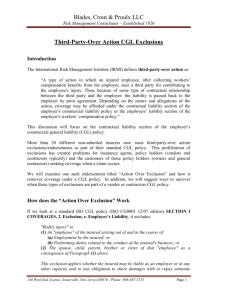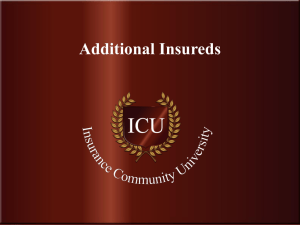Damage to Impaired Property or Property Not
advertisement

Commercial General Liability Insurance, Part I 2.23 insurable. The exclusion applies only to the product itself, not to any damage or injury caused by the product. For example, if a hair dryer is defective and does not produce warm air, there is no coverage for the product defect. However, if the defect in the hair dryer causes it to catch fire and results in property damage to a customer’s property, coverage would exist for that property damage. There is an exception to the exclusion for damage to the insured’s work, and this exception helps to explain the distinction between these two exclusions. The exception for damage to the insured’s work applies if the damaged work, or the work that caused the damage, was performed on behalf of the insured by a subcontractor. The damage to work exclusion applies primarily to construction work, and, therefore, the exception for work performed by a subcontractor is important. However, this exception applies to work that has been completed, not to work in progress. The exclusions discussed for property owned by an insured would eliminate coverage for most property owned by an insured while work is being performed. For example, if a general contractor completes a building that is found to have a defect in the electrical wiring that requires the wiring to be replaced, coverage may exist under the exception if the wiring was installed by a subcontractor. This exception can be deleted by the Damage To Work Performed by Subcontractors On Your Behalf endorsement (CG 22 94). Damage to Impaired Property or Property Not Physically Injured In the course of commerce—in particular, manufacturing—a host of businesses produce various components used to make a final product. If one of those components fails to operate in accordance with design parameters, the cost of replacing such a failed or an inadequately performing component is not covered by the CGL because of the exclusion for damage to impaired property or property not physically injured. As an example, if a capacitor for a television were deficient because of improper temperature tolerances and this deficiency resulted in a need to replace the capacitors in 100,000 televisions, coverage would not exist under the CGL for the replacement costs. The policy definition for “impaired property” defines impaired property as tangible property (other than the insured’s product or work) that cannot be used or is less useful because it includes a product of the insured’s that is defective—if the property could be restored to use by the repair, replacement, or removal of the insured’s product. Under this definition, property that is impaired because of a defect in the insured’s product is excluded. However, the definition and the exclusion’s title imply that if the insured’s product does cause physical injury to another party’s property, there would be coverage. To continue the preceding example, if the insured’s capacitor caused the television to overheat and melted essential components beyond repair, there would be coverage for the damage to the television but not to the capacitor. © 2011 American Institute For Chartered Property Casualty Underwriters and subject to all copyright laws | www.TheInstitutes.org 2.24 Commercial Liability Risk Management and Insurance There is an exception to this exclusion. The exclusion does not apply to the loss of use of other property arising out of sudden and accidental physical injury to the insured’s product or work after it has been put to its intended use. If a contractor improperly wires a heating unit and it catches fire, the claim by the building owner for loss of use of the building while the unit is being repaired or replaced would be covered. Recall of Products, Work, or Impaired Property To slightly revise the example in the previous section regarding the television capacitor, if the television manufacturer needed to recall the 100,000 televisions, the capacitor manufacturer would not be covered under the CGL for recall or replacement costs, and neither would the television manufacturer, because of the same exclusion. Coverage for product recall expense is available through the Limited Product Withdrawal Expense Endorsement (CG 04 36) or the Product Withdrawal Coverage Form (CG 00 66). See the exhibit “Practice Exercise—Property Damage Exclusions and Exceptions.” Practice Exercise—Property Damage Exclusions and Exceptions Water Cooler Manufacturer (WCM), a water cooler manufacturer, recently discovered that 10,000 of its water coolers (the H2O 9000 model) leak due to defective seals. These seals were manufactured by Manufacturing Company. WCM discovered the problem when one of its customers complained about a leak after her area rug was damaged by water leaking from the cooler. She requested that WCM cover the cost of $800 to replace her rug. The cost of recalling the units and making the necessary repairs is $120,000. WCM asks Manufacturing Co. to cover all of these costs. There was no indemnification clause in the contract between WCM and Manufacturing Co. Question Will Manufacturing Company’s CGL policy provide coverage? Answer Manufacturing Company’s CGL policy will most likely provide coverage for the damaged rug if the leak was caused by Manufacturing Comoany’s seal. However, because of the exclusion for costs incurred by the insured or others for recall of products, the CGL policy will not cover the recall costs unless there was an endorsement added to provide this coverage. [DA06654] Exclusions Without Exceptions These CGL Coverage A exclusions do not contain exceptions: • Workers Compensation • War © 2011 American Institute For Chartered Property Casualty Underwriters and subject to all copyright laws | www.TheInstitutes.org Commercial General Liability Insurance, Part I 2.25 • Personal and Advertising Injury • Electronic Data • Distribution of Material in Violation of Statutes Workers Compensation The CGL coverage form excludes coverage for liability of the insured under any workers compensation, disability benefits, unemployment compensation, or similar law. The purpose of the exclusion is to eliminate duplication between the CGL coverage form and other policies specifically designed to provide protection for employees. Coverage for injuries to the employees of third parties that result from the products or operations of the insured can be complex. Workers compensation is primary coverage, and the workers compensation policy of the employer whose employee is injured in the course and scope of employment should respond. However, if the insured’s product or operations caused the injury, the employee may have a cause of action, apart from workers compensation, against the insured. The workers compensation insurer may have a subrogation claim against any recovery by the employee for both past and future benefits provided. Additionally, the employer and/or the workers compensation insurer may have a cause of action to recover the amount of benefits paid against the CGL insured. See the exhibit “Workers Compensation and the CGL.” War The 2001 edition and several prior editions of the CGL coverage form contained a war exclusion that provided an exception if the insured had assumed liability related to acts of war under a contract. In 2002, ISO introduced a mandatory CGL endorsement that excluded bodily injury or property damage arising directly or indirectly out of war, regardless of whether the insured had assumed such liability under a contract. This change was necessitated by a legal environment in which insureds could be sued directly for war-related losses. When ISO revised the CGL coverage form in 2004, the new war exclusion, without an exception, was added to the form. The same exclusion was retained in the 2007 edition of the CGL coverage form. This exclusion does not apply to acts of terrorism. Coverage is provided for many commercial loss exposures through the Terrorism Risk Insurance Act (TRIA). Personal and Advertising Injury An exclusion for bodily injury arising out of personal and advertising injury applies to Coverage A of the CGL coverage form. The purpose of this exclusion is to eliminate duplicate coverage under Coverage A for bodily injury that might result from an offense covered under Coverage B—Personal and © 2011 American Institute For Chartered Property Casualty Underwriters and subject to all copyright laws | www.TheInstitutes.org 2.26 Commercial Liability Risk Management and Insurance Workers Compensation and the CGL ✓ Reality Check The majority of employers are required by state law to have workers compensation insurance, and this requirement cannot be met by the CGL. It is important, even in economically difficult times, for employers to have workers compensation coverage. It is also important to understand that even when there seems to be duplicate coverage, the insurance principle that a loss should never result in a profit (or “double dipping”) still applies. This example illustrates how coverage under a workers compensation policy may intersect with coverage under a third-party CGL policy. Leif, an employee who is unloading a floral arrangement from a Fresh Flowers delivery van outside an office complex, is struck by a steel girder dropped from Heron’s crane. Leif sustains severe head and spinal cord injuries. Fresh Flowers’ workers compensation insurer, WCI, pays $1,273,000 in medical benefits and $57,450 in indemnity benefits over a three-year period for Leif’s injuries. Heron has an each occurrence CGL limit of $1 million. Leif files suit against Heron for damages, including pain and suffering. WCI files a subrogation lien with the court of jurisdiction for Leif’s suit against Heron. Heron’s commercial general liability insurer offers the policy limits of $1 million to settle Leif’s suit, and Leif agrees to the settlement. WCI, rather than proceed to a court hearing on distribution of Leif’s settlement, negotiates a lien settlement with Leif’s attorney for $527,000. Although Heron and its CGL insurer have resolved all of their financial responsibility for this claim through the settlement, WCI remains responsible for Leif’s future medical and indemnity benefits. [DA06655] Advertising Injury. Bodily injury resulting from any of the offenses, such as false arrest or wrongful eviction, included in the policy definition of “personal and advertising injury” is covered under Coverage B and subject to the Coverage B limit of insurance rather than the each occurrence limit that applies to Coverage A. Electronic Data The definition of “property damage” in the CGL is limited to tangible property, and the definition states that electronic data are not considered tangible property. The electronic data exclusion was added to the CGL coverage form in 2004 to reinforce the definition that electronic data are not considered tangible property. Limited coverage for liability for the electronic data loss exposure can be added by the Electronic Data Liability endorsement (CG 04 37). Broader coverage can be provided by the Electronic Data Liability Coverage Form (CG 00 65). © 2011 American Institute For Chartered Property Casualty Underwriters and subject to all copyright laws | www.TheInstitutes.org


